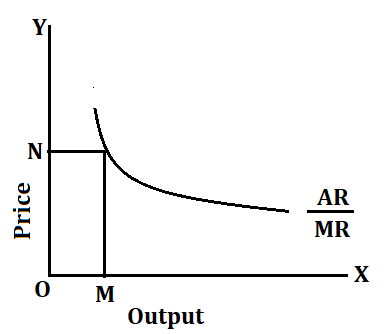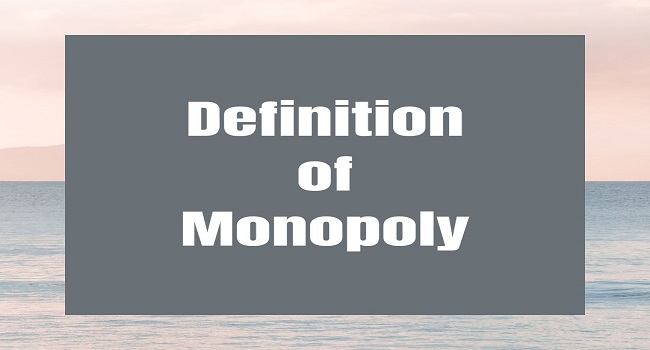Definition of Monopoly:
The word monopoly is made up of two syllables- mono and poly. Mono means single while poly implies selling. Thus, if there is only one single seller of a product in the market, that situation will be referred to as a monopoly. But this is only a literal meaning of the term monopoly. Actually, the term monopoly in Economics is linked with the degree of competition prevalent in the market. If in a market there is one single seller of a product and there is no competition at all, the situation will be one of pure or perfect or absolute monopoly. Further, the distinction between the firm and the industry (so important under perfect competition) disappears altogether under pure monopoly. The firm is also the industry. In technical language, we may define pure or perfect monopoly as a single-firm industry where the cross-elasticity of demand between the product of the firm and that of other commodities in the market is zero. The product under pure monopoly is so powerful that he can fix any fantastic price for his product. He is in a position to take even the whole of all consumers’ income whatever the level of his output.
The average revenue curve of a firm under pure monopoly will be a rectangular hyperbola with an elasticity of demand equal to unity as shown below. The consumers will spend all their income on the firms’ product, whatever its price. Since the elasticity of the firm’s average revenue curve is equal to one, the consumer’s total outlay on the firm’s product will be the same at every price. The firms under pure monopoly take the whole of the community’s income all the time. It should, however, be remembered that even a firm under pure monopoly cannot fix both the price of its product as well as the amount which will be demanded. It can fix either the price or the quantity to be sold. It cannot fix both prices as well as the output to be sold. If, for example, it fixes the price at ON, then the output to be sold (OM) will be determined by the consumers who will decide how much to buy at that price. If, on the contrary, it fixes the output to be sold (OM) then the price will have to be left to the consumers who will decide what price to pay when the output was at a given level. Thus, even the all-powerful pure monopolist cannot fix the prices well as the output simultaneously. This, however, is the only limitation on the power of the pure monopolist. For the rest, he enjoys absolute and unlimited freedom to do as he pleases. It should be noted carefully that, since the total revenue of the firm remains constant at all levels of output under pure monopoly, the marginal revenue is bound to be zero. That is the reason why the marginal revenue curve has not been shown separately in the diagram. Since the marginal revenue is zero, the marginal revenue curve coincides with the X-axis.

The question now is: How shall a firm under pure monopoly fix its output and price? As the firm under pure monopoly earns a fixed and constant amount of money (the entire money income of the community), it will be able to maximize its profits only when its total costs are as low as possible. The total costs will, of course, be the lowest if it produces an exceedingly small output (say, one unit) and sells it at an exorbitant price. Actually speaking, no firm anywhere is so powerful as to sell a small output (say, one unit) at an exceedingly high price and succeed in taking away the entire mone-income of the community. Pure monopoly, is, therefore, a myth. It has never existed anywhere. It is only a figment of the imagination of theoretical economists. In contrast, pure or perfect competition is a reality, at least in the food-stuffs and raw materials markets.
Let us now turn to the other type of monopoly, namely, imperfect or limited monopoly, which is a very much realistic market situation. What does imperfect or limited monopoly signify? An imperfect monopoly refers to that market situation in which there is a single seller of the product for which there are no close substitutes. In other words, the substitutes of the product are available in the market, but they are not close substitutes. The position of the monopolist under imperfect monopoly is weaker compared to that of his counterpart under pure monopoly. He has to reckon with the possibility of some substitutes for his product, though they may not be close substitutes. He is, therefore, not as powerful as the pure monopolist. An electric supply company in a town may be considered an example of an imperfect monopoly, because the electricity being supplied by it has gas, kerosene, and candles as substitute, though these are not close substitutes of electricity.
Further, like pure monopoly, the distinction between firm and industry disappears under imperfect monopoly as well. The firm is not only a firm; it is an industry as well. The firm has an average revenue curve that slopes downwards in the same manner as the demand curve for the product of an industry descends downwards. In technical language, we may define imperfect or limited monopoly as a single-firm industry where the cross-elasticity of demand between the product of the firm and that of other commodities in the market is small, though it is above zero. Pure monopoly is a myth but imperfect monopoly is not. Imperfect monopoly is very much a reality.









Comments (No)